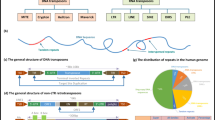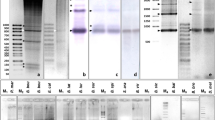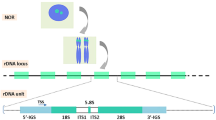Abstract
A RELATIVELY small proportion of the total DNA of eukaryotic cells has been considered to be transcribed and translated; the rest of the genome may be variously categorised into several subsets such as spacer and repeated DNAs. Such nontranslated sequences presumably have a role in the modulation of transcription and in the organisation of chromosomes. Some satellite DNAs may be extremely simple in sequence1, even in human DNA2. Other repeated DNAs showing greater sequence complexity have been considered to form a separate subset of repeated DNAs2,3. Very recently, the exact base sequence of such complex repeats has been determined in a few organisms4,5. The conservation of such sequences between related species, and even more extensively in the evolutionary tree, is not known. We report here data which indicate the base order of a subset of human repeated DNA which is fairly complex in sequence. We have shown that such human DNA repeats are quite well conserved both in nucleotide sequence order and in nominal repeat length between human and lower primates.
This is a preview of subscription content, access via your institution
Access options
Subscribe to this journal
Receive 51 print issues and online access
$199.00 per year
only $3.90 per issue
Buy this article
- Purchase on Springer Link
- Instant access to full article PDF
Prices may be subject to local taxes which are calculated during checkout
Similar content being viewed by others
References
Endow, S. A., Polan, M. L. & Gall, J. G. J. molec. Biol 96, 665–692 (1975).
Manuelidis, L. Chromosoma 66, 1–21 (1978).
Manuelidis, L. Nucleic Acids Res. 3, 3063–3076 (1976).
Brutlag, D., Carlson, M., Fry, K. & Hsieh, T. S. Cold Spring Harb. Symp. quant. Biol. (in the press).
Rosenberg, H., Singer, M. & Rosenberg, M. Science 200, 394–402 (1978).
Maio, J. J. J. molec. Biol. 56, 579–595 (1971).
Gross, H. J. et al. Nature 273, 203–208 (1978).
Gilbert, W. in RNA Polymerase, (eds Losick, R. & Chamberlin, M.) 193–205 (Cold Spring Harbor, New York, 1976).
Newrock, K., Cohen, C. H., Hendricks, M., Donnelly, R. & Weinberg, E. S. Cell 14, 327–336 (1978).
White, R. & Hogness, D. Cell 10, 177–192 (1977).
Musich, P. R., Maio, J. J. & Brown, F. L. J. molec. Biol. 117, 657–677 (1977).
Jeffries, A. J. & Flavell, R. A. Cell 12, 429–439 (1977).
Reddy, V. B. et al. Science 200, 494–502 (1978).
Manuelidis, L. Chromosoma 66, 23–32 (1978).
Miller, D. A. Science 198, 1116–1124 (1977).
Sedat, J. & Manuelidis, L. Cold Spring Harb. Symp. quant. Biology 42, 331–350 (1978).
Maxam, A. M. & Gilbert, W. Proc. natn. Acad. Sci. U.S.A. 74, 560–564 (1977).
Author information
Authors and Affiliations
Rights and permissions
About this article
Cite this article
MANUELIDIS, L., WU, J. Homology between human and simian repeated DNA. Nature 276, 92–94 (1978). https://doi.org/10.1038/276092a0
Received:
Accepted:
Issue Date:
DOI: https://doi.org/10.1038/276092a0
This article is cited by
-
Structural and dynamic mechanisms of CBF3-guided centromeric nucleosome formation
Nature Communications (2021)
-
DNA replication acts as an error correction mechanism to maintain centromere identity by restricting CENP-A to centromeres
Nature Cell Biology (2019)
-
Live visualization of genomic loci with BiFC-TALE
Scientific Reports (2017)
-
Large Tandem, Higher Order Repeats and Regularly Dispersed Repeat Units Contribute Substantially to Divergence Between Human and Chimpanzee Y Chromosomes
Journal of Molecular Evolution (2011)
-
CENP-B box and pJα sequence distribution in human alpha satellite higher-order repeats (HOR)
Chromosome Research (2006)
Comments
By submitting a comment you agree to abide by our Terms and Community Guidelines. If you find something abusive or that does not comply with our terms or guidelines please flag it as inappropriate.



